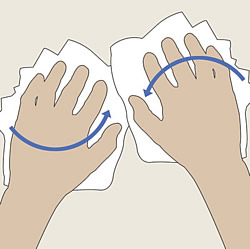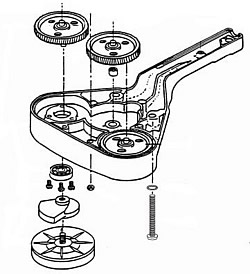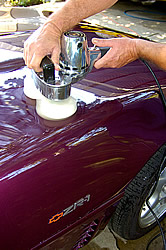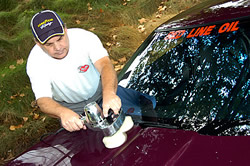Practical Car Care for Corvette Owners: Polishing - Page 2 of 2
© 2007 by Hib Halverson
No use without permission, All Rights Reserved
 Discuss this article
Discuss this article
The patented Cyclo is a timeless piece of equipment which has changed little since it was introduced in 1953. Its unique feature is the overlapping, orbital motion of the two heads which mimics the two-handed manual polishing/waxing technique that some hard-core waxers use when they do their cars by hand. The Cyclo's polishing heads are spun by a transmission driven by the device's motor. The heads are dynamically-balanced such that, when the unit is running, there is no vibration. The way this works is similar to how balance shafts in four-cylinder and V-6 engines damp engine "shake" at lower engine speeds.
This was a no-brainer. I needed one of these two-headed buffer gizmos.
A week later, FedEx Ground was back with a box from Cyclo Toolmakers. In it was a Cyclo Model 5 (PN 80-010), the 110-volt electric unit powered by a 1/3-hp, carbon-brush motor which turns its heads at about 3000 rpm. There are three other Cyclos, two for use with 230-volt power and a third which is pneumatic. All share the same transmission and head assemblies. My Model 5 was fitted with optional, DoublePrecision, quick-connect adapters in place of the standard head assemblies.
Now, I had polish, an electric polisher and no more excuses.
The first step in what I call "practical waxing for non-waxers" is to wash the car. Washing is covered in a separate article linked to this story. Once the car has been washed per those instructions, take a good look at the condition of the paint.
If you see a lot of moderate-to-heavy scratches, heavy oxidation and places where the paint is down to the primer or the clearcoat has failed. Don't waste time reading this. Repaint the car. If you don't have paint failure but there's a lot of moderate scratching and moderate-to-heavy oxidation, you need to rub out the paint with some aggressive cleaners and medium abrasives which is, also, beyond the scope of this article. If you see a few very minor scratches and no oxidation, proceed straight to the wax application section, below.
If you see minor scratches, maybe a few medium scratches or chips, slight oxidation along with slight amounts of other contamination bonded to the paint or clear coat, we suggest that, before polishing, you use the Cyclo, fitted with Polishing Pads (PN 77-120, colored green), to apply Cyclo "Cleaner--Deoxidizer" (PN 84-159, 16 oz; PN 84-151, 1 gal.).
 |
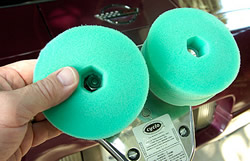 |
Click image for larger view
Cyclo Toolmakers has a wide variety of pads available. We tested both the green and the white units. Green is best for polishing or removing light oxidation. White is better for final buffing although we used it for applying polish, too. The yellow "cutting pads", which we did not use, are for compounding and scratch removal. Other pads are available including more aggressive cutting and scrubbing pads, along with microfiber pad covers, brushes and even abrasive discs. Image: Author |
Click image for larger view
One thing we really liked was the Cyclo's quick disconnect option which allows you to change pads easily by pushing them on and snapping them off. Image: Author |
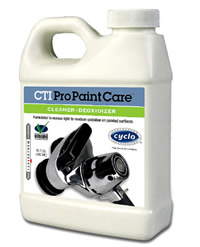 |
 |
Click image for larger view
Cyclo Toolmakers sells a line of high-quality, paint care products. They're available in four steps, from a very aggressive rubbing compound to polish/sealant. We tried "Cleaner--Oxidizer" and found it a good choice for removal of tiny scratches, slight oxidation and surface stains. It comes in pints and gallons. Image: Cyclo Toolmakers, Inc. |
Click image for larger view
When you apply C-Magic, remember: a little goes a long way. Dab a spot of polish about the size of a nickel on each pad. Image: Author |
Pick your first panel, but do not apply the product directly to the surface, itself. Pour about a cap-full of Cleaner--Deoxidzer on each pad. Touch the heads to the paint and slide them around a bit, then fire-up the polisher. Spread Cleaner--Deoxizer over an area 2-feet by 2-feet. Now go back over the area, this time applying a little pressure to work the product into the surface. Move the Cyclo such that the swirls it leaves overlap by 1/8-3/16-inch. On vertical sections use same speed and orientation across curves, but you'll need to push on the tool a a little harder to give it the same pressure. On curved or radiused areas, orient the polisher such that a line though the center of the two heads parallels the ridge line. Do about a 2'x2' area then reload the pads.
During the Cleaner-Deoxidzer application, if the pads develop a gray tinge, they're picking up dirt. Remove them and soak them in warm soap and water. Aggressively compress and release them to force the dirt out. Rinse the pads then let them to dry a bit before using them again. Compressing them tightly then free-spinning them with the Cyclo accelerates the drying process. It's more convenient to have two sets of Polishing Pads. That way your less likely to be held-up waiting for a set of pads to dry enough to be used again.
Once Cleaner--Deoxidizer is applied and has dried to a white haze, it can be removed with either a general purpose, microfiber towel or by rewashing the surface per our instructions in the sidebar on washing.
Now, install a pair of Finishing Pads (PN 77-110, colored white) on your Cyclo. Shake the container of C-Magic World Class Wax. Remove the cap, discard the shipping plug, replace the cap then squeeze about a nickel's worth of polish on each pad. We suggest applying polish one 2x2' section at a time. Touch the heads to the surface, slide them a bit then click-on the Cyclo. Use the same motion in the above discussion about Cleaner--Deoxidizer but not as much pressure. On horizontal surfaces the weight of the Cyclo itself is just about enough. On vertical panels you'll need to push a bit. Use the same movement as before, so swirls of wax overlap about an eighth inch. If you're using the right movement, it's not necessary to go over areas you're already done a second time, but it won't hurt if you do.
Generally, you'll need to reload the pads for each 2'x2' section. The polish is formulated such that a little goes a long way--no more than a about a nickel's worth per pad, per section. When you get to a spot where the spinning pads are to difficult to use, such as brake cooling ducts, tail light wells, side vents, antenna bezels and the areas around side view mirrors or door handles, simply pop one of the Cyclo's pads off its quick-connect adapter and use it like you would a hand applicator. Once the entire car is done, let the polish dry to a haze.
Step 2 is to spray C-Magic Detail Wax over the polish on a panel-by-panel basis. The Detail Wax is a sort of "activator" which reacts with the polish to produce the maximum protection available. Again, you don't need to use a lot--just "mist" it on.
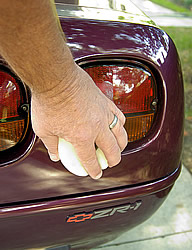 |
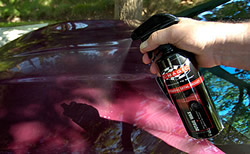 |
Click image for larger view
When you get to the nooks-and-crannies, simply unsnap one of the Cyclo's pads, dab a little more C-Magic on it and use it as a hand applicator. The quick-disconnect adapters make this easy to do. Image: Author |
Click image for larger view
Use C-Magic Detail Wax sparingly. The best way to describe its application is "misting it on". Image: Author |
Now, you're ready for the only part which is done by hand but lazy guys, such as myself, need not worry. There's no vigorous hand buffing, just easy wiping with microfiber polishing towels. If you're eyeing those freshly-washed bath towels sitting the the dryer, don't be tempted. They're called "bath" towels because they belong in the bathroom not in the garage. For car care, you need microfiber towels. Why microfiber is so good is covered in a sidebar article liked to this story.
On a panel-by-panel basis, lightly spray Detail Wax over the haze left by the World Class Wax. While the surface is still wet, wipe the haze away with the microfiber towel of your choice. When the haze is gone and the surface is dry, your C-Magic application is complete.
Unlike carnuba wax products, World Class Wax--don't forget, it's really a polish--does not yellow as successive applications build up. In fact, the finish becomes more deep and has more clarity if you do it twice. This is especially noticeable on dark colored cars and we saw it with two we polished, the LeMans Blue, '04 Z06 and the Dark Purple Metallic, '95 ZR-1.
 |
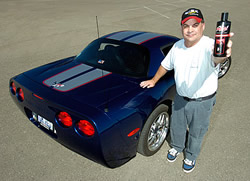 |
Click image for larger view
For the final step, finish polishing, even lazy folks like us will work by hand. California Car Duster's microfiber "Plush Towel" was our favorite for the last step of the polish job because of the different textures on each of its sides. Image: Author |
Click image for larger view
Our lazy, nonwaxer Author and his just-polished Z06. Word is that he now 1) is yet another C-Magic convert and 2) promises to polish his car more often. Image: CAC Staff |
Under normal conditions, C-Magic, when applied according to the guidelines posted here, will last about four-six months. Previous applications do not need to be stripped prior to a fresh application but, if you are intent upon, wax stripping each time, follow the procedure discussed in our sidebar on washing.
C-Magic
Suite 100
2205 Stonegate
Denton TX 76205
866.760.2929
www.cmagicwax.com
California Car Duster Company
9525 DeSoto Av.
Chatsworth CA 91311
800.282.8828
www.waterblade.com
Cyclo Toolmakers
Bldg. C
1740 Skyway Dr.
Longmont CO 80504
303.485.1990
www.cyclotoolmakers.com
Eastwood Company
263 Shoemaker Rd.
Pottstown PA 19464
800.345.1178
www.eastwoodco.com

